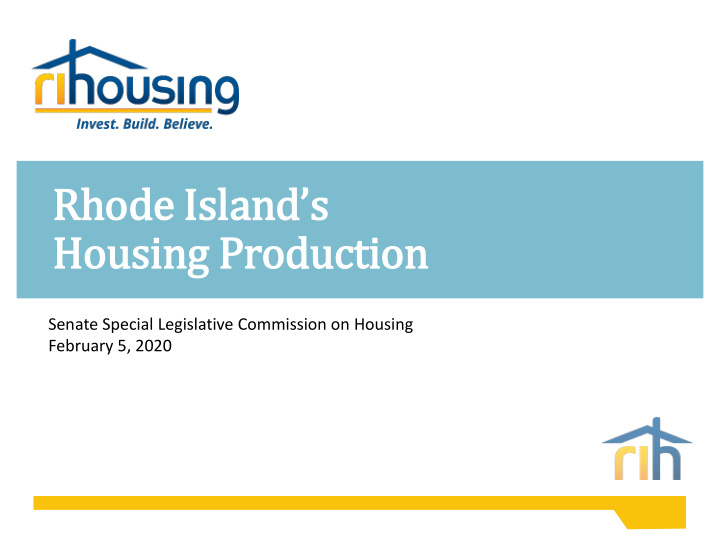



Rhode Island’s Housing Production Senate Special Legislative Commission on Housing February 5, 2020
Our Mis ission • To ensure that Rhode Islanders can secure a healthy home that meets their budget and their needs by: Making and servicing loans to buy homes Providing assistance to homeowners and renters Financing the construction & preservation of healthy, affordable homes in communities across the state • Self-supporting quasi-public agency – no state funding for operations 2
Rhode Island’s Housing Challenges 1) We are not producing cing enough gh new units ts Leads to tight markets and low vacancy Failing to replace older homes 2) We are not producing cing units ts at a range ge of price ce points nts Lack of supply for those classified as extremely low income and those workforce housing bracket 3) Demographic ographic change e is creating ting demand and for new housing ing types es Aging in place 3
National Trends • Nationwide construction activity is barely keeping pace with household growth Only 1.2 million units added in 2019 Excluding recession years, lowest production rate since 1982 4 Joint Center for Housing Studies State of the Nation’s Housing, 2019.
Production Trends in in Rhode Is Island • Production has not recovered from the recession • Estimated 2000 new homes built in 2018 5 New permits data from Census Building Permits Survey. Historic rehab data estimated from state & federal historic tax credits.
Production by Region Permits rmits Issued sued in n 2018 18 v Permitting activity Providence Increased activity in & Kent County 6 HousingWorks RI 2019 Fact Book.
Production by Type Mul ultifam tifamily ily Permits rmits Issue ued d in 2018 18 v Multifamily development in Providence • Very limited multifamily development in other 25 communities with less than 10 multifamily 2018 7 HousingWorks RI 2019 Fact Book.
Agin ing Housing Stock • RI has some of the oldest housing stock in the country 30% of housing built before 1940 • Estimated 500+ units lost every year to deterioration, demolition, or conversion • Production rate needs to keep up with natural turnover 8 RIHousing analysis of Census American Community Survey, 2014-2018.
Preserving Aff ffordable Housing • Estimated 6,000 rental units have affordability restrictions expiring by 2024 • Without preservation financing, these units are at risk of becoming unaffordable Omni Point, Providence Prospect Heights, Pawtucket 9 RIHousing analysis of tax credit records & National Housing Preservation Database.
Barriers to Producti tion • Regulatory and zoning barriers Minimum lot size Long approval process Additional impact fees • Recent study ranks Rhode Island as the 3rd most highly regulated construction market in the country • Drives up development costs and impedes production 10 National Bureau of Economic Research, Local Residential Land Use Regulatory Environment Across US Housing Markets, 2020.
Data Sources for Production Census sus Build ilding ing Perm rmits its Survey Municipa nicipal Perm rmit itting ting Data ta • Reported by municipalities • Comprehensive database of all permits, including historic rehab • Captures permits, not starts or occupancy • Up-to-date & detailed • New construction only – no rehabs or renovations • Not reported to state or Can use Historic Tax Credit Census data to estimate 11
Consequences of of Lo Low Producti tion: Declining Rental Vaca cancy • Slow production is leading to tight market conditions • Current rental vacancy is 3% • Healthy rental vacancy rate is 7-8% 12 CoStar multifamily vacancy survey. * Historically a rate of 7-8% is associated with stable rent prices (Lincoln Institute of Land Policy; Joint Center for Housing Studies)
Consequences of of Lo Low Producti tion: Ris ising Rental Costs • Rents for 2-bed have increased 10% since 2014, studios have increased by 22% • Renter incomes have increased less than 0.5% • 46% of renters are cost- burdened 13 Rents from RIHousing Rent Survey (based on analysis of CoStar multifamily database). Median renter income & cost burden from Census American Community Survey. All values shown in 2019 dollars.
Consequences of f Low Producti tion: Tig ight Sales In Inventory • Balanced sales market has 5- 6 months of inventory Current statewide inventory: 3.5 months • Leading to increased sales prices • Returning to pre-recession prices 14 Price and inventory data from Rhode Island MLS. Sales price shown in 2019 dollars.
Aff ffordability Mis ismatch • Ongoing ‘mismatch’ between household income and unit price • Very tight inventory of homes affordable to those classified as extremely low-income 50,000 households below 30% AMI (<$25,000 per year) 30,000 units available in this price range 15 Analysis of Census PUMS data, 2013-2017.
Aff ffordability Mis ismatch • Limited supply of appropriately-priced rentals for those on the higher end of the workforce housing bracket 24,000 households earning 100-150% AMI ($73,000 - $90,000 per year) 11,000 units in this price range 16 Analysis of Census PUMS data, 2013-2017.
Uneven Production Patterns • Need to produce units at a range of price points • Current rental production is skewed towards higher- priced units 50% of units priced above $1600 per month 17 RIHousing analysis of CoStar multifamily database.
Agin ing Population • Fastest-growing age group in RI People 65+ as Proportion of State Population • Need for accessible housing 17.5% options to age in community 17.0% 16.5% • Preference for housing near 16.0% transit, community services, and 15.5% retail 15.0% 14.5% 14.0% 13.5% 13.0% 2010 2011 2012 2013 2014 2015 2016 2017 2018 18 Census Population Estimates Survey, 2010-2018.
Questions? 19
Recommend
More recommend